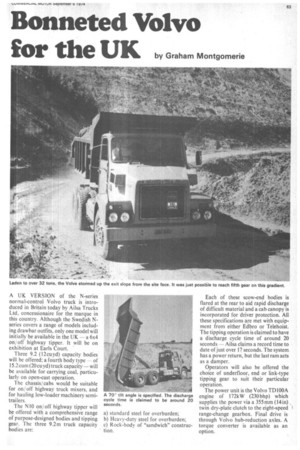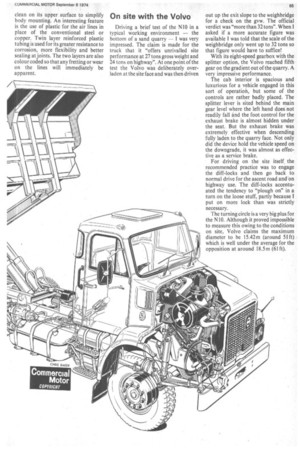Bonneted Volvo
Page 65

Page 66

Page 67

If you've noticed an error in this article please click here to report it so we can fix it.
for the UK by Graham Montgomerie A UK VERSION of the N-series normal-control Volvo truck is introduced in Britain today by Ailsa Trucks Ltd, concessionaire for the marque in this country. Although the Swedish Nseries covers a range of models including drawbar outfits, only one model will initially be available in the UK — a 6x4 on/ off highway tipper. It will be on exhibition at Earls Court.
Three 9.2 ( I 2 cu yd) capacity bodies will be offered; a fourth body type — of 15.2 cum (20 cu yd) truck capacity —will be available for carrying coal, particularly on open-cast operation.
The chassis/ cabs would be suitable for on/ off highway truck mixers, and for hauling low-loader machinery semitrailers.
The N l0 on/ off highway tipper will be offered with a comprehensive range of purpose-designed bodies and tipping gear. The three 9.2m truck capacity bodies are: a) standard steel for overburden; b) Heavy-duty steel for overburden; c) Rock-body of "sandwich" construction. Each of these scow-end bodies is flared at the rear to aid rapid discharge of difficult material and a cab canopy is incorporated for driver protection. All these specifications are met with equipment from either Edbro or Telehoist. The tipping operation is claimed to have a discharge cycle time of around 20 seconds — Ailsa claims a record time to date of just over 17 seconds. The system has a power return, but the last ram acts as a damper.
Operators will also be offered the choice of underfloor, end or link-type tipping gear to suit their particular operation. The power unit is the Volvo TD100A engine of 172kW (230 bhp) which supplies the power via a 355 mm (14 in) twin dry-plate clutch to the eight-speed range-change gearbox. Final drive is through Volvo hub-reduction axles. A torque converter is available as an option. A new eight-rod bogie, which Volvo claims gives up to 12.70 of articulation, is fitted; the top rods are in V-formation from the differential out to the cross-member and the bottom rods are parallel.
Chassis features include a frame construction which uses rolled sidemembers with extra thick flanges and thin lightweight webs, said to give strength with lightness. The frame is clean on its upper surface to simplify body mounting. An interesting feature is the use of plastic for the air lines in place of the conventional steel or copper. Twin layer reinforced plastic tubing is used for its greater resistance to corrosion, more flexibility and better sealing at joints. The two layers are also colour coded so that any fretting or wear on the lines will immediately be apparent.
On site with the Volvo
Driving a brief test of the N 10 in a typical wosking environment — the bottom of a sand quarry — I was very impressed. The claim is made for the truck that it "offers unrivalled site performance at 27 tons gross weight and 24 tons on highway". At one point of the test the Volvo was deliberately overladen at the site face and was then driven out up the exit slope to the weighbridge for a check on the gvw. The official verdict was "more than 32 tons". When I asked if a more accurate figure was available I was told that the scale of the weighbridge only went up to 32 tons so that figure would have to suffice!
With its eight-speed gearbox with the splitter option, the Volvo reached fifth• gear on the gradient out of the quarry. A very impressive performance.
The cab interior is spacious and luxurious for a vehicle engaged in this sort of operation, but some of the controls are rather badly placed. The splitter lever is sited behind the main gear level where the left hand doeg not readily fall and the foot control for the exhaust brake is almost hidden under the seat. But the exhaust brake was extremely effective when descending fully laden to the quarry face. Not only did the device hold the vehicle speed on the downgrade, it was almost as effective as a service brake.
For driving on the site itself, the recommended practice was to engage the diff-locks and then go back to normal drive for the ascent road and on highway use. The diff-locks accentuated the tendency to "plough on" in a turn on the loose stuff, partly because I put on more lock than was strictly necessary.
The turning circle is a very big plus for the NIO. Although it proved impossible to measure this owing to the conditions on site, Volvo claims the maximum diameter to be 15.42m (around 51 ft) which is well under the average for the opposition at around 18.5m (61 ft).


























































































































































